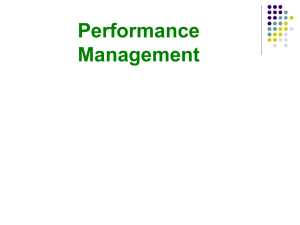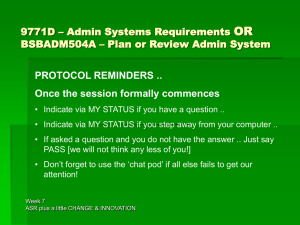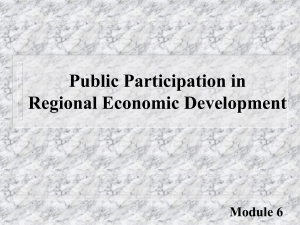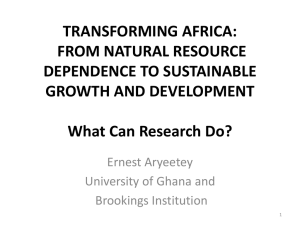International Financial Management: An Overview
advertisement
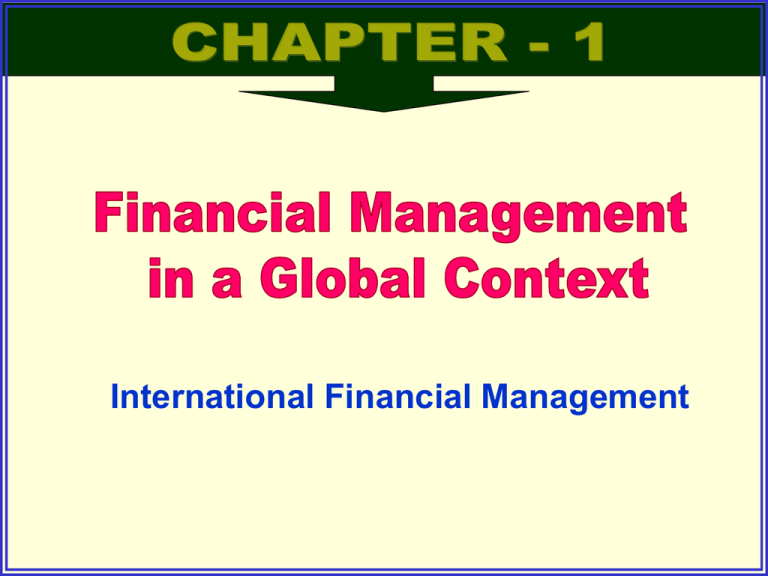
International Financial Management 1.1 Why Study International Finance • In today's world finance anything but international cannot be • Enormous growth international trade volume of in the • Cross border capital flows and, in particular, direct investment have also grown enormously 1.1 Why Study International Finance (contd.) • Veritable (Genuine) revolution has been taking place in the money and capital markets around the world • Liberalization, integration and innovation have created a giant international financial market which is extremely dynamic and complex 1.1 Why Study International Finance (contd.) • Multilateral negotiations regarding phased removal of trade barriers have made considerable progress and WTO had emerged as a meaningful platform • Post war, World trade has grown faster than World GDP • Almost all countries getting integrated with the global economy 1.1 Why Study International Finance (contd.) • Indian economy needs substantial amount of foreign capital to augment domestic savings • Technology up-gradation in India will require continuing import of foreign technology, hardware and software • India’s increasing recourse to commercial borrowings and direct and portfolio investments by nonresidents 1.1 Why Study International Finance (contd.) • The efforts of Indian companies to diversify into exports of engineering equipment and turnkey projects will have to be supported by the ability to offer long term financing to buyers • A number of companies particularly in the Indian IT sector have begun venturing abroad for strategic reasons either as partners in joint ventures or by establishing foreign subsidiaries 1.1 Why Study International Finance (contd.) • India's growing dependence on international financial markets – Debt – Equity – FII investment • Indian companies have also been venturing abroad for setting up joint ventures and wholly owned subsidiaries 1.1 Why Study International Finance (contd.) • For those who are willing to master its complexities the global financial market provides endless opportunities for creative financial management • Finance managers must come to grips with with the conceptual foundations and practical issues of instruments and markets 1.2 The Finance Function • The finance function in a firm can be conveniently divided into two subfunctions viz. accounting and control and treasury management • Decisions taken by the treasurer have implications for the controller and vice versa 1.2 The Finance Function (contd.) • Treasury Function: Acquisition and allocation of financial resources so as to minimize the cost and maximize the return, consistent with the level of financial risk acceptable to the firm is the core of treasury management • Accounting and Control: Internal and External Reporting, MIS, Control, etc. 1.3 The Emerging Challenges • Five key categories of emerging challenges can be identified – To keep up-to-date with significant environmental changes and analyze their implications for the firm – To understand and analyze the complex interrelationships between relevant environmental variables and corporate responses 1.3 The Emerging Challenges (contd.) – To be able to adapt the finance function to significant changes in the firm's own strategic posture – To take in stride past failures and mistakes to minimize their adverse impact – To design and implement effective solutions to take advantage of the opportunities offered by the markets and advances in financial theory 1.4 Recent Challenges in Global Financial Markets • The outstanding feature of the changes during the eighties was integration • Both the potential borrower and the potential investor have a wide range of choice of markets 1.4 Recent Challenges in Global Financial Markets (contd.) • Deregulation within the financial systems of the major industrial nations • Assets denominated in currencies became more substitutable various nearly 1.4 Recent Challenges in Global Financial Markets (contd.) • Deregulation involved action on two fronts – Eliminating the segmentation of the markets for financial services – permitting foreign financial institutions to enter the national markets and compete on an equal footing with the domestic institutions • This is a part of the overall trend towards securitisation and disintermediation 1.4 Recent Challenges in Global Financial Markets (contd.) • The attainment of the Economic and Monetary Union (EMU) and the birth of Euro in the closing years of the decade of 1990's What’s Special about “International” Finance? • • • • Foreign Exchange Risk Political Risk Market Imperfections Expanded Opportunity Set What’s Special about “International” Finance? • Foreign Exchange Risk – The risk that foreign currency profits may evaporate in dollar terms due to unanticipated unfavorable exchange rate movements. • Political Risk – Sovereign governments have the right to regulate the movement of goods, capital, and people across their borders. These laws sometimes change in unexpected ways. What’s Special about “International” Finance? • Market Imperfections – Legal restrictions on movement of goods, people, and money – Transactions costs – Shipping costs – Tax arbitrage What’s Special about “International” Finance? • Expanded Opportunity Set – It doesn’t make sense to play in only one corner of the sandbox. – True for corporations as well as individual investors. Financial Markets and its Interlinkages Financial Markets Capital Market Primary Market Secondary Market Money Market Call Money Markets T Bills Market Gilt Market Commercial Paper Market Certificate of Deposits Forex Market Spot Market Forward Market



